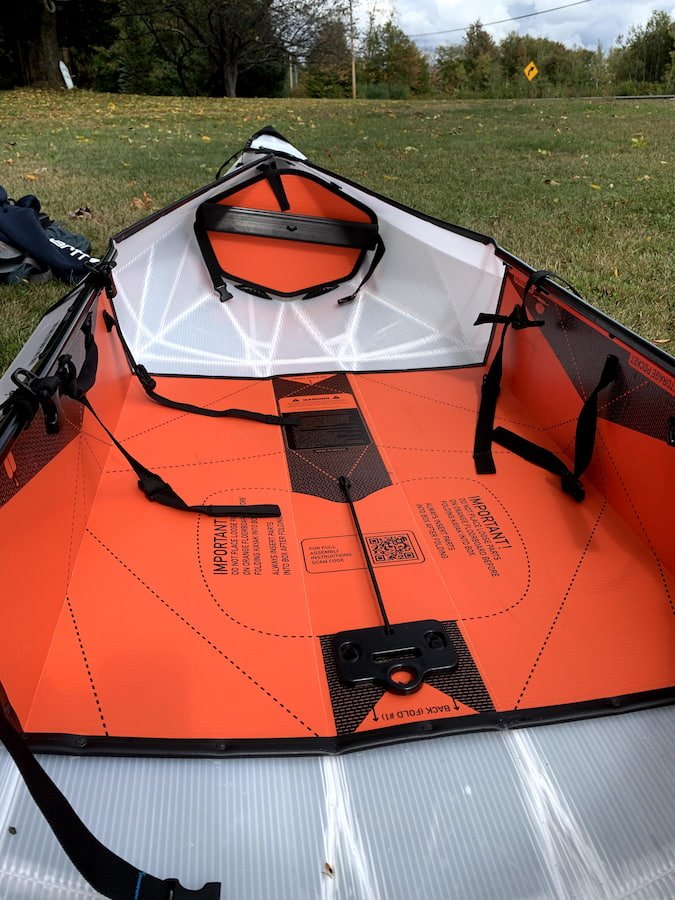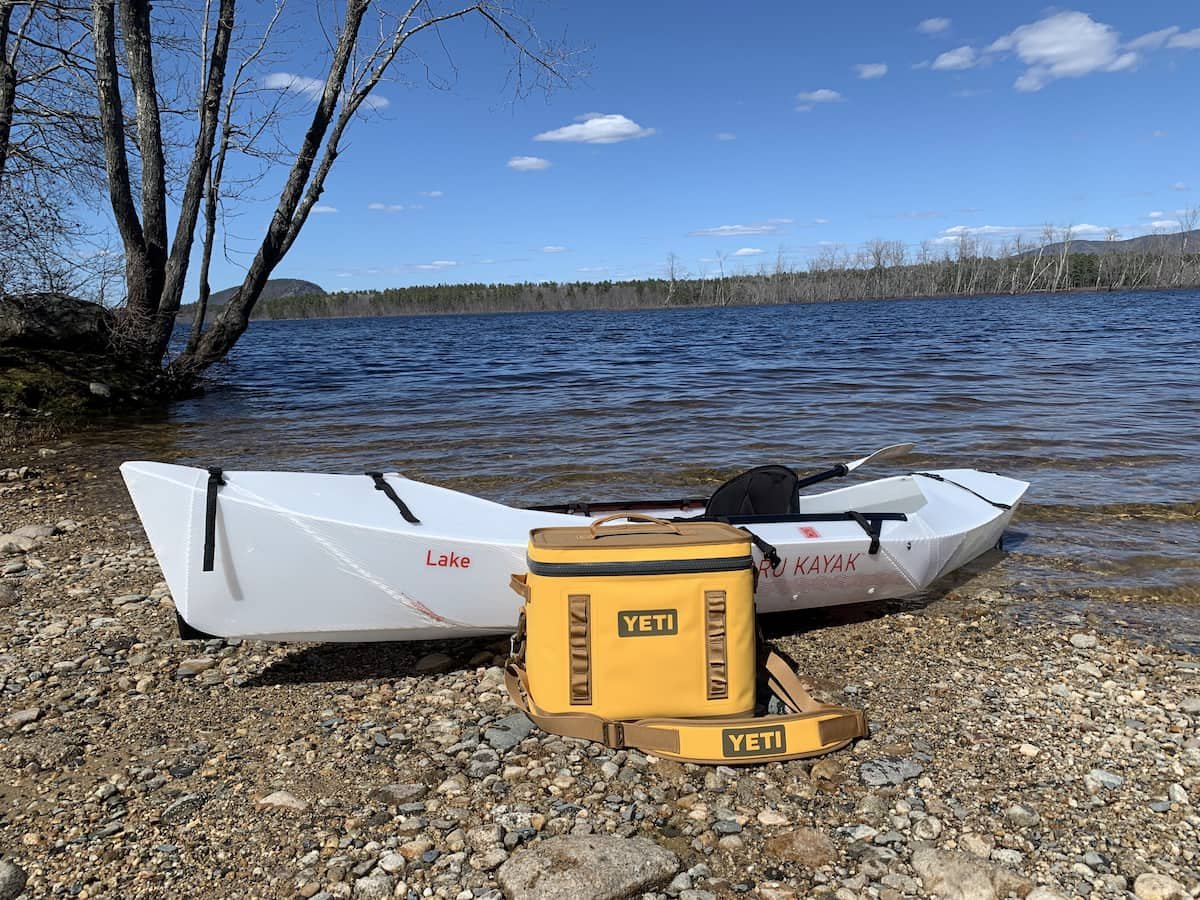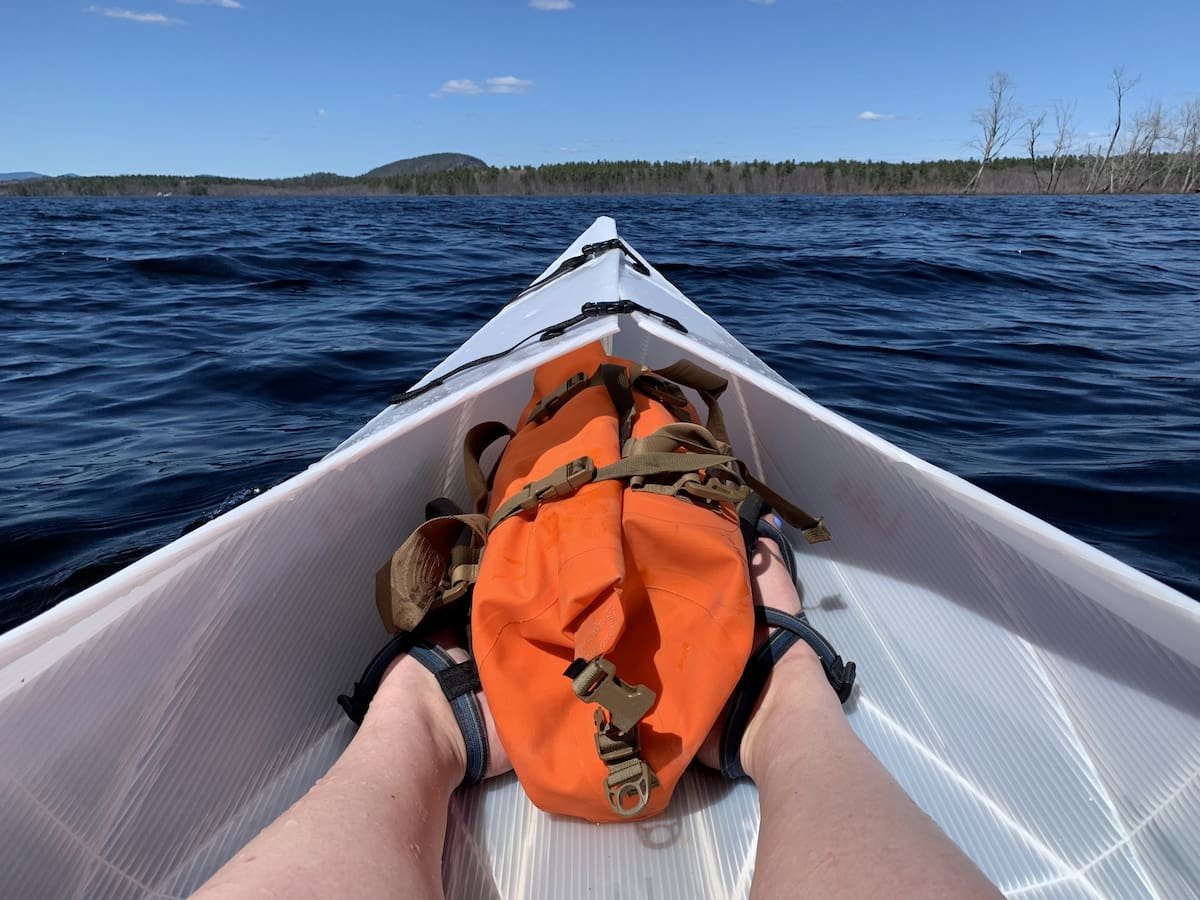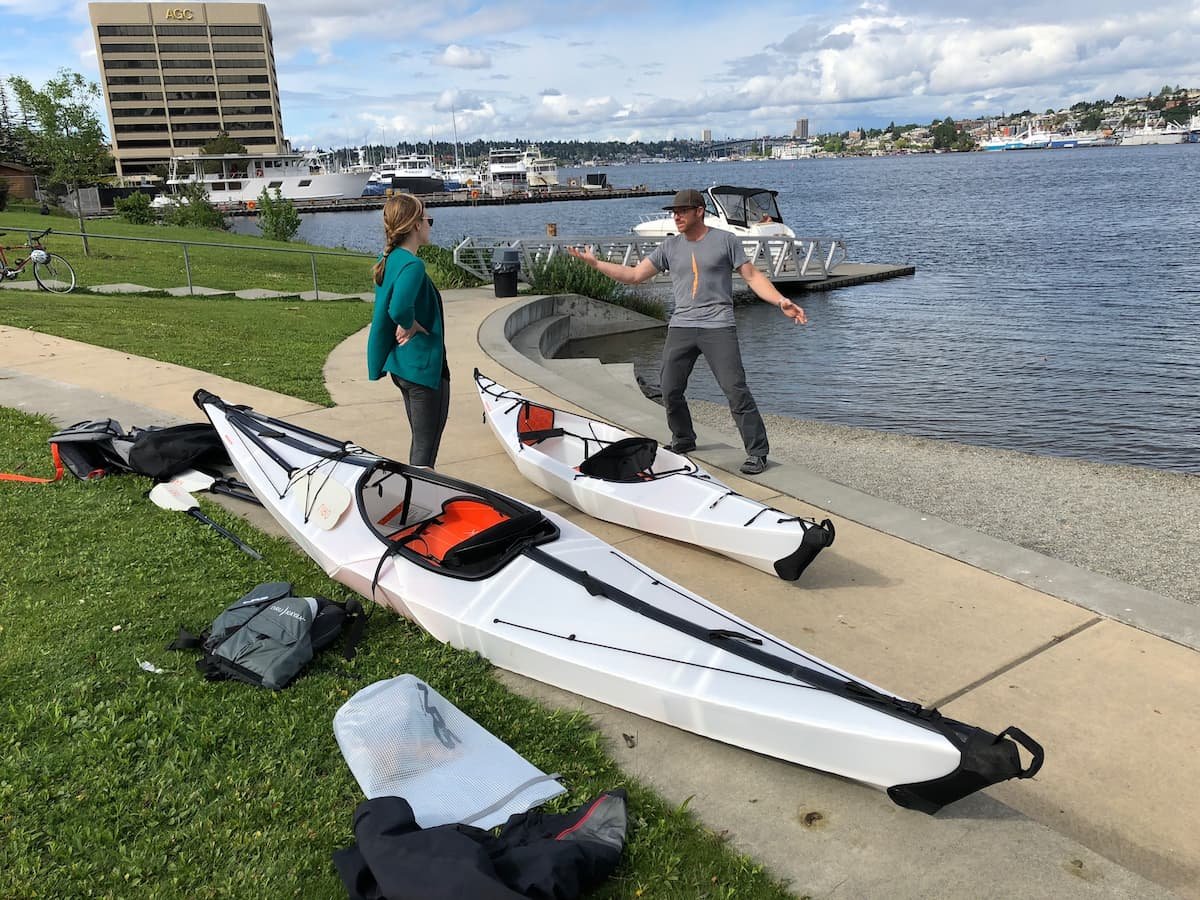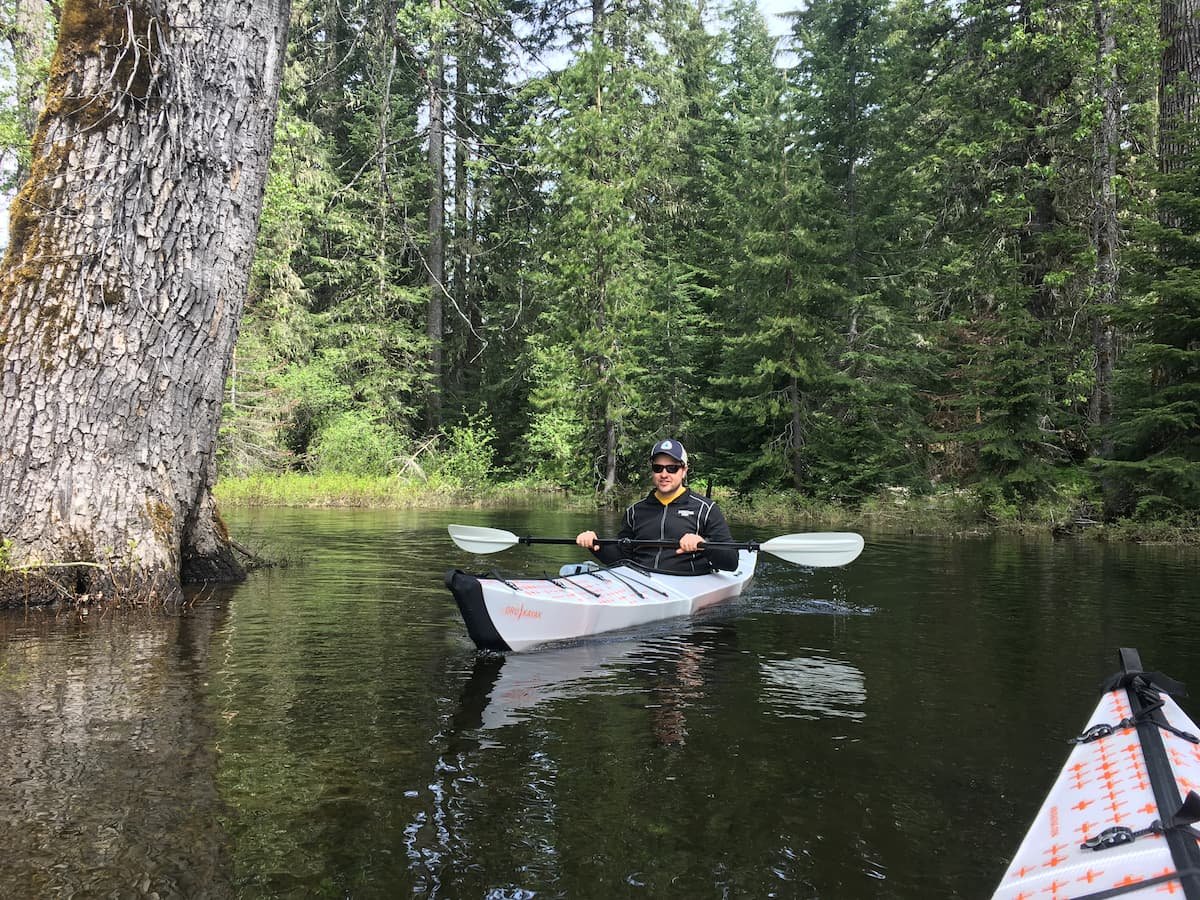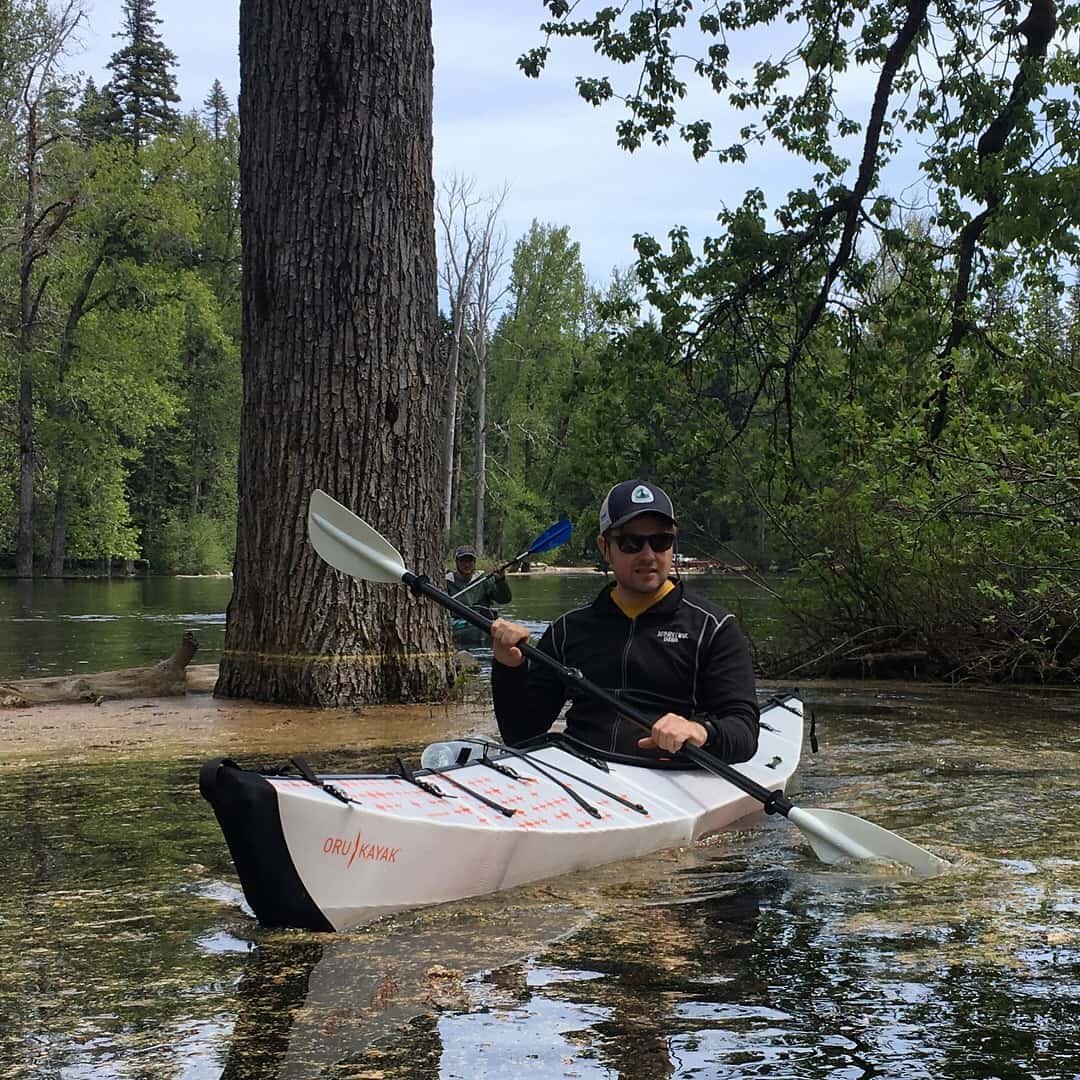Oru Kayak Review: Should You Buy a Folding Oru Kayak?
You want a high quality boat that you can transport in the trunk of your car.
What should you get?
June 6th, 2024
Home > Gear Reviews > Water Sports
For most people that enjoy kayaking, the main drawbacks to owning one are storage and transportation. If you live in a small space, it’s likely not feasible to store a traditional 12-foot kayak in your home. Likewise, if you don’t own a vehicle, transportation for a kayak is next to impossible.
Sure, you can rent a kayak, but over time that can make a significant dent in your wallet, and you have to operate around a rental company’s schedule.
And often, you’ll find that the best paddling destinations are a little off the beaten path.
Folding kayaks, inflatable kayaks, and packrafts are gaining a lot of talk lately because they’re easy to store and transport. You can also travel with them and hike to places that you wouldn’t otherwise be able to paddle on.
For those just looking for a leisurely lake float, a packraft will do. But, if you want something with more utility that will provide enjoyment on different types of water, we think a folding Oru kayak is the way to go.
They cost essentially the same as a rotomolded kayak or inflatable kayak that serve the same purpose. Oru kayaks fold down to about a 25 lb backpack that can be tucked away in the back of a closet or under the bed until they’re ready to be used. They fit in the trunk of a car (so a roof rack isn’t required) and can be brought on a plane, train, or bus. Oru kayaks also come with 30-day guarantee and a three-year warranty.
For this article, we’ve been testing Oru kayaks for 5 years from Washington to Maine, from Colorado to California, in calm ocean bays and in alpine lakes. Here’s what we think you should consider if you’re thinking about an Oru folding kayak.
We create reader-supported, objective gear reviews independently selected by our editors. This story may contain affiliate links, which help fund our website. When you click on the links to purchase gear, we may get a commission, without costing you an extra cent. Thank you for supporting our work and mission of outdoor coverage for every body! Learn more.
Oru Kayak Comparison Tables
Price, Experience Level, Assembly Time, Dimensions
| ORU KAYAK MODEL | MSRP* | BEST FOR | EXPERIENCE LEVEL | WATER TYPE | ASSEMBLY TIME | WEIGHT | LENGTH | WIDTH | KAYAK BOX | COCKPIT |
|---|---|---|---|---|---|---|---|---|---|---|
| Oru Lake | $499 | Day trips on flat water lakes | Beginner | Calm | 1 - 3 min | 17 lbs | 9'0" | 32" | 42 x 10 x 18" | 24" x 66" |
| Oru Lake Sport | $699 | Longer days on flat water | Beginner | Calm | 1 - 3 min | 18 lbs | 9'0" | 32" | 43 x 11 x 22" | 24" x 66" |
| Oru Inlet | $899 | Day trips on calm water with a dog or small child | Beginner | Calm | 3 - 5 min | 20 lbs | 9'8" | 31" | 42 x 10 x 18" | 23" x 44" |
| Oru Beach LT | $1,199 | Day trips and casual, flat water paddling | Beginner | Calm | 5 - 10 min | 25 lbs | 12'1" | 29" | 33 x 12 x 29" | 24" x 69" |
| Oru Beach LT Sport | $1,499 | Longer days on the water with cameras and extra gear | Beginner | Calm | 10 - 15 min | 28 lbs | 12'1" | 29" | 33 x 13 x 29" | 24" x 69" |
Max Paddler Height, Weight Capacity, Features
| ORU KAYAK MODEL | MAX PADDLER HEIGHT | WEIGHT CAPACITY | ADJUSTABLE FOOTREST | ADJUSTABLE BACKREST | SKIRT-READY COCKPIT | THIGH BRACES | STORAGE CAPACITY |
|---|---|---|---|---|---|---|---|
| Oru Lake | 6'4" | 250 lbs | No | No | Splash-deck only | No | Info not available |
| Oru Lake Sport | 6'4" | 250 lbs | Yes | Yes | Splash-deck only | No | Info not available |
| Oru Inlet | 6'2" | 275 lbs | Yes | Yes | Splash-deck only | No | Info not available |
| Oru Beach LT | 6’6” | 300 lbs | Yes | Yes | Splash-deck only | No | 140 liters |
| Oru Beach LT Sport | 6’6” | 300 lbs | Yes | Yes | Splash-deck only | No | 140 liters |
The Oru kayak is a real boat. One of our testers, Scott, testing the Oru Inlet on the Carquinez Straits in California’s Bay Area. Photo courtesy Scott Williams.
WHAT IS A FOLDING ORU KAYAK?
The origami-style folding Oru kayaks are made from a single sheet of hard, corrugated plastic (polypropylene, to be exact). They come folded up in a backpack and are pretty easily assembled into 12-16 ft long, seafaring vessels. Oru is a Kickstarter success story, launching in 2013 and reaching its goal almost immediately.
The 25-40 pound, made in California origami kayaks pack down to medium suitcase size that can be carried on your back (their exact packed down dimensions are 33 in x 12 in x 29 in).
Since the original launch, they’ve added and redesigned models to their lineup, which currently sits at eight different options: the Bay ST, the Beach LT, the Beach LT Sport, the Coast XT, the Inlet, the Lake, upgraded Lake Sport, and a tandem model, the Haven TT.
Traveling with an Oru is pretty straightforward. If you’re flying, these boats can be checked on a plane, and in most cases, will count as carry-on baggage (with no extra fee). One Treeline Review reader even carries her Oru on the New York subway. But, to travel with your kayak, you’ll need to purchase the Oru Pack or the Lake/Inlet Pack, which is a heavy-duty nylon backpack that fits the kayak and other accessories.
Even if you’re not planning on flying, the Oru Pack makes any kind of traveling or hiking with the kayak more effortless and convenient. They truly are a portable kayak. Note that the pack is not compatible with the tandem model, the Oru Haven TT.
Inside view of the Oru Inlet, which we tested on waterways in California and Maine. Photo courtesy Josette Deschambeault.
WHAT ARE THE DIFFERENCES BETWEEN THE ORU KAYAK MODELS?
Oru currently has eight different models in their lineup. We’ve outlined the main differences below, but if you still need help deciding which kayak is right for you—try Oru’s online quiz!
Price: $499
Weight: 17 lbs
Experience Level: Beginner
Water Type: Calm
Assembly Time: 1-3 minutes
Much like the Oru Inlet that we tested previously, the Oru Lake is designed for light and fast fun. Sporting an under 2-minute assembly time, the Oru Lake weighs a mere 17 pounds, the lightest kayak on the market. It’s small enough to tuck in your hall closet after a quick paddle on your local pond. The Oru Lake is like the pared-down cousin to the uber-popular Oru Inlet folding kayak.
The Lake uses just two main components (the folding origami-esque hull and a structured seat/floorboard); this is minimal compared to other Oru kayaks that use additional bulkhead components to provide structure to the boat. So the Oru Lake is not only lighter, but it also gives you more free space for leg room or storage, being the same dimensions as the Oru Inlet.
The Oru Lake is designed for those with limited storage options: shared space, smaller apartments in the city, living out of a van, etc. It’s all the fun of a kayak, minus sacrificing your ability to get out and paddle at a moment’s notice.
One of Treeline Review’s writers tested the Oru Lake on lakes across Maine. Photo courtesy Josette Deschambeault.
Our tester took the Oru Lake out on Lovewell Pond in Western Maine on a warm and breezy spring day. The Oru Lake handled well for such a light craft, and it sped through the water easily, but our tester found that even the smallest of waves (about 4-inches on that day) had an easy time crashing over the low-riding walls of the kayak. Fortunately, the boat was not swamped, but the dry bags proved their worth!
The Oru Lake has room for gear storage. Photo courtesy Josette Deschambeault.
Paddling into the wind was easier than expected with the Lake’s low profile and super-light design, but the hull easily held up to the weeds, sticks, and gravel beach. We wouldn’t paddle the Oru Lake into heavy waves, but we would highly recommend it to our friends who want an easy, compact, and lightweight boating setup!
Oru Lake Sport
Price: $699
Weight: 18 lbs
Experience Level: Beginner
Water Type: Calm
Assembly Time: 1-3 minutes
Much like the Oru Lake, the Oru Lake Sport is an updated version designed to be more comfortable and adjustable. It has nearly the same specs, but has an upgraded thicker seat cushion and more straps for customizing the fit to your body. One notable difference is that the footrest is included and it is adjustable. It also has a thicker, knob adjustable seat back to control the height, which is an upgrade from the Lake. The floor board on the Lake Sport also has added trim and an additional support seat wall.
Similar to the Bay ST and Coast XT, which are Oru's more advanced kayaks, the Oru Sport has a splash-deck ready cockpit. However, the Lake Sport is half the price of those models and best suited for calmer waters. You'll have to purchase the splash-deck separately. You also can also swap in the Oru Gel Seat Cushion on the Lake Sport model.
While the Oru Lake is the lightest kayak on the market, the Lake Sport is nearly as light weighing 18 pounds (compared to the Lake's 17 pounds) in a box that is about an inch wider and two inches thicker. The assembly time is the same as the Lake, making it a good choice for someone looking for the lightest kayak with more comfort than the Lake.
Price: $899
Weight: 20 lbs
Experience Level: Beginner
Water Type: Calm
Assembly Time: 3-5 minutes
The Inlet is a recreational kayak best suited for beginners and calm water. With a new origami fold pattern, the Inlet has a weight capacity of 275 pounds and a maximum paddler height of 6'2", yet it only weighs 20 pounds!
Our tester in Maine found that everything in this kayak held together well despite being so lightweight, and they felt comfortable paddling regardless. The adjustable backrest and adjustable foot bars gave them enough leverage to speed up paddling as desired.
Although recommended for flatwater, our other tester was impressed by how it handled and tracked on the Carquinez Straits in California’s Bay Area, even against a strong tide.
Additionally, disassembling the kayak took less than 5 minutes, making it the perfect kayak for those with limited storage, time, and familiarity with kayaking.
It should also be noted that our testers do not recommend using this boat for waves larger than a calm 3-4 inches, so it is not something you want to use for sea kayaking or whitewater rapids. However, it’s a perfect fit for those looking to paddle lakes, ponds, reservoirs, and lazy rivers.
Price: $1,199
Weight: 25 lbs
Experience Level: Beginner
Water Type: Calm
Assembly Time: 5-10 minutes
The Beach LT model is for light, easy kayaking. It’s suited for day trips down a lazy river or paddling along flat, calm water. At 29" wide and a nearly flat bottom, stability is its stand-out feature. As a result, it’s best suited for beginners and first-time kayakers. The newest version of the Beach LT is even easier to assemble, use, and even has a new exterior print pattern design.
Price: $1,499
Weight: 28 lbs
Experience Level: Beginner
Water Type: Calm
Assembly Time: 10-15 minutes
Released in 2023, Oru takes the Beach LT and upgrades it with additional features for the Beach LT Sport. Most notably, it adds an integrated rail system for mounting cameras and fishing rod holders and is considered the most angler-friendly of the Oru kayaks. The open cockpit makes it easy to get in and out of the kayak — and makes it easier to access your gear.
Oru also added fairings to the ends to reduce drag and protect against scrapes. A new gel seat helps you to stay comfortable for long days on the water.
And it’s black!
Price: $1,499
Weight: 26 lbs
Experience Level: Beginner to Advanced
Water Type: Choppy
Assembly Time: 10-15 minutes
The Bay ST is the original do-it-all kayak designed for casual cruising, fishing, long day paddles, and overnight trips. It’s the kayak you’d take down a swift-moving river, a leisurely day on the lake, or a multi-day adventure. The Oru Bay is the best one for most situations. Oru’s updated version is more durable, featuring a closed-cockpit, new aluminum cockpit latches, extra-reinforced strap anchor points, and an updated print pattern.
Price: $2,199
Weight: 32 lbs
Experience Level: Intermediate to Advanced
Water Type: Heavy surf
Assembly Time: 10-15 minutes
The Coast XT is the model for more serious adventurers. While an experienced kayaker can likely handle the Oru Bay ST kayak in more challenging conditions, the Coast XT is made for them. It’s a longer, heavier model that can pack more gear and is made for serious expeditions. It’s not the one beginner paddlers should choose. For those new to kayaking but still want the experience of longer, overnight journeys, the Bay ST should hold all the gear required while offering easier manageability.
Previously, upgraded models were available of the Bay ST and Beach LT versions. However, those have been taken off the market in place of optional extras that you can add to each currently available model. Like the Bay ST, the newest version of the Coast XT is made more sturdy by its new aluminum cockpit latches and extra-reinforced strap anchor points.
Price: $1,999
Weight: 41 lbs
Experience Level: Beginner to Intermediate
Water Type: Calm
Assembly Time: 10-15 minutes
The Haven TT is Oru's tandem kayak, but it is also easily converted to a single-seater. It's rated for 500 pounds, the most in Oru's lineup—a full 100 pounds more than the Coast XT. The Haven TT also has the largest hull of Oru's kayaks. The integrated track system supports accessories such as cup holders, fishing rods, and camera mounts. The Haven TT is best suited for flatwater kayaking. The newest version of the Haven features sturdy straps, buckles, reinforced accessory-holding rails, as well as a new print pattern.
The Beach LT and Bay ST Oru kayaks. Photo by Hannah Weinberger
ORU KAYAK ACCESSORIES
Oru sells many upgrade accessories (although adding extra accessories will bring the total cost of your kayak to more than the list price). If buying Oru-branded extras aren’t in your budget (or you just don’t want to), there are Facebook pages and YouTube videos dedicated to Oru hacks that will help you modify your kayak on your own. Beware: depending on the modification, this may void the one-year Oru warranty.
Here are the accessories we think are worth purchasing, all available at the Oru Kayak website:
ORU PADDLE
The Oru Paddle (or the Oru Carbon Paddle, which is almost a pound lighter) isn’t necessary to paddle the boat—any paddle will do. But, the matching white paddle breaks down into four parts and tucks away nicely when the kayak is in box form, which is a significant bonus for traveling. Both the length of the paddle and the feather angle of the blades are adjustable.
The Oru Fiberglass paddle is a half-pound lighter than the standard Oru paddle, adjustable length, adjustable blade pitch, and comes with a mesh storage bag.
SPRAY SKIRT (BAY ST AND COAST XT ONLY)
The adjustable Nylon Spray Skirt fits tightly around the cockpit and keeps your lower body dry while paddling moderate waters. A must-have if you don’t want to get wet. The Beach LT, Haven TT, and Inlet models are not spray skirt compatible.
The Neoprene Spray Skirt upgrade to the nylon version offers better spray protection with a weather-tested seal. Like the nylon skirt, it is designed to fit the Coast XT and Bay ST models only.
SPLASH DECK (BEACH LT, Lake, LAKE SPORT, and Inlet ONLY)
It’s not a full spray skirt, but the nylon Oru Splash Deck (for Beach LT or for Lake, Lake Sport, and Inlet) will minimize water in your kayak. Note this is compatible with the Oru Beach LT model only.
SEAT WEDGE
The Oru Seat Wedge is a thin piece of foam that fits perfectly under the existing seat and is worth the money for the added padding under your hipbones it provides.
Our tester Scott holding an Oru paddle and wearing the Oru backpack for testing on some of the calmer bays in the Bay Area. Photo courtesy Scott Williams.
ORU PACK and Oru Inlet Pack
The Oru Pack and Oru Inlet/Lake Pack are heavy-duty nylon backpacks that make transportation and carrying a cinch (in fact, it’s needed for airline travel).
It also has room to hold extra accessories, like paddles. It’s got padded shoulder straps, a hip belt, compression straps, and a top and side handle. Unfortunately, neither pack is compatible with the tandem model, the Haven TT.
ORU WATERPROOF BACKPACK
The Oru waterproof backpack is for gear that you don’t want to get wet. The main compartment is waterproof, and the front pocket is splash-resistant. We found it’s more convenient to carry gear using this pack than a dry bag.
Oru FLOAT BAGS
The Oru Float Bags and Lake Float Bags are a set of bags that allow the kayak to stay afloat and remain maneuverable if you capsize or take on water. Worth the peace of mind if you’re concerned about having a mishap out on the water.
Oru Dry Bags
Made of Toba-Tex with welded seams, the Oru Dry Bags are essential for keeping your gear dry. They come in two sizes—2-liter and 15-liter.
Oru Repair Kit
We think a repair kit for essential gear is, well, essential. Don’t leave home without one.
ORU Personal flotation device (PFD)
We never paddle without a life jacket or PFD. Oru has partnered with NRS to make the Oru PFD (personal flotation device). We find it is quite reasonably priced for a PFD of its quality.
See our guides to Best Life Jackets and Personal Flotation Devices and Best Life Jackets for Kids for more recommendations.
Mountable Accessories
Oru makes life easier with mountable accessories, including a camera mount, phone mount, and cup holder. Be sure you check compatibility with your kayak.
fishing accessories
Oru makes a mountable fishing rod holder to make it easier to fish from your kayak.
If you’re planning to fish from your Oru kayak, see our guides to Best Beginner Fly Fishing Combos, Best Fly Fishing Indicators, and our Fly Fishing Accessories Checklist.
Water Shoes
When on the boat, it is possible your shoes may get wet. Many kayakers prefer to use water shoes or sandals. See our guide to Best Hiking Sandals or Best Wet Wading Shoes for models we recommend.
WHO SHOULD CONSIDER AN ORU KAYAK?
We researched other foldable kayak brands, including Pakboats, TRAK, KERO, Long Haul, HYPAR, and the now-defunct Feathercraft and Folbot. However, our research showed that Oru Kayak is the brand that reigns in this category. So if you’re considering a folding kayak, in particular, we think the Oru is the top of the line in this class.
Each model is designed for a specific purpose, and they can handle everything from light beginner recreational paddling to experienced paddling in challenging conditions. If you want to paddle but don’t have the space to store a traditional kayak or transport it, you are right to consider purchasing an Oru.
If you’re someone who wants to hike to a lake and can handle carrying 30-ish lbs on your back, they can take you places a regular kayak can’t. If you’re strictly looking for a casual lake float, a 7-pound packraft will do the trick. But, if you want to be more connected with the water and you want more versatility out of your boat, an Oru folding kayak has a lot more to offer.
If you rent kayaks often, owning an Oru can take the place of that. If you travel frequently or live life on the road, they can be checked on an airplane easily or stored in an RV without taking up too much space. They easily fit in the trunk of most cars, so you don’t need a roof rack. And finally, if you’re a design-focused buyer, they’re cool; they look like life-size folded origami on the water and are sure to start conversations with fellow paddlers.
Looking for Where to Kayak? See our Water guides:
The origami-style folding Oru kayaks are made from a single sheet of hard, corrugated plastic. Photo by Hannah Weinberger.
PROS OF OWNING AN ORU KAYAK
IT’S A REAL BOAT
Oru kayaks can handle most journeys—depending on the model—ranging from a light lake paddle to faster-flowing rivers. They’re designed to take Class 1 (easy, with very little whitewater and easy maneuvering) and Class 2 (moderate, with some straightforward rapids that require maneuvering) rivers. This rating means that they’re good for beginner paddlers and experienced paddlers alike. Some people report that they could manage Class 3 rapids in their Oru without issue, but they aren’t recommended to be used in those conditions.
THEY’RE PORTABLE
The most significant advantage to owning an Oru foldable kayak is that you can take it just about anywhere. The backpack weight (at around 25-30 lbs depending on the model) shouldn’t be a problem for most people accustomed to carrying a pack while hiking. The folded-down kayak may be a little cumbersome and awkward for some, but much less so than trying to haul a traditional kayak around. They fit in the trunk of a car. And, you can fly with them, which is a huge bonus if you’re traveling to a place with opportunities to paddle.
If you’re looking for other portable boats, see our guides to Best Inflatable Kayaks and Best Packrafts for other alternatives.
Loading two Oru Kayaks into the back of a Subaru while testing on a local waterway in Portland, Oregon. Photo courtesy Kate Hoch.
THEY’RE LIGHTWEIGHT
Oru kayaks range between 20 and 40 pounds, depending on the model, whereas inflatable kayaks weigh 35+ pounds, and rotomolded kayaks can weigh over 60 pounds. So if you want a lightweight kayak, Orus are in a class of their own.
THEY CAN BE STORED EASILY
An Oru can easily be tucked away in a closet, under a bed, or wherever you have a few extra feet of space. A folding kayak is a good alternative for city or apartment dwellers who like to get outside.
Our tester Dan hiked in the Oru folding kayak to Disappearing Lake in Washington. This is only possible because of the lightweight of the Oru and the easy transport with the Oru backpack. Note that the “lake” is ephemeral and about 1-foot deep. Nonetheless, we recommend wearing a PFD while boating. Photo by Kate Hoch.
YOU CAN PACK QUITE A BIT OF GEAR WITH YOU
Orus hold anywhere from 90 to 180 liters of storage, depending on the model. Outside Online reported that they carried 220 pounds in the Oru Bay kayak (a 150-pound person and 70 pounds of gear in the ST model) without issue.
They also note that “because the boat splits in half down the middle, loading it up with gear for an overnight adventure is much easier than packing bags into the small cargo holds of a traditional kayak.”
THEY’RE PRETTY EASY TO ASSEMBLE
We’ve read that they can be folded together in anywhere from five to thirty minutes. The first couple of times assembly may be tricky, but the more you practice, the quicker assembly becomes. Disassembly seems quicker, with most people eventually getting their time down to five or ten minutes. There is a learning curve, though.
THEY’RE STABLE, AND THEY TRACK WELL (ENOUGH)
Our tester Hannah Weinberger told me, “They're noticeably stable, enough that I was able to stand up in them, and I found them really easy to maneuver, even in conditions with some wind,” adding that she “found the skirt-ready Bay ST to be a lot more responsive and resistant to tipping than the Beach LT, but the Beach was fun and stable and had great legroom. Both seemed to track sufficiently well, despite neither having a rudder.”
Regenold said of the Bay ST model that “the kayak is responsive and fast, its lightweight and sharp keel letting me paddle up to full speed in seconds. It’s stable and tracks straight but is nimble enough to lean and brace.”
THEY’RE QUICK ON THE WATER
You can really motor in an Oru. Because they’re lightweight and sleek, you can paddle as fast as a regular kayak. Gear Junkie said of the Bay ST that “the kayak is responsive and fast, its lightweight and sharp keel letting me paddle up to full speed in seconds.”
THEY’RE DURABLE
Oru kayaks are rated for 20,000 folds without weakening. Outside Online reported that it held up well after a year of significant use, with only a few small things to fail, but nothing that meant it wouldn’t float.
That’s not to say that durability issues haven’t been reported. Some reviewers have noted early holes forming in the neoprene covering that fits over the end of the kayak. Others have complained of hardware not holding up after not a lot of use. Outside Online also noted that “tabs and buckles wear out with regular use.” But, overall, we’ve found that most people have said that their well-used foldable kayaks have held up as expected.
THEY GLOW
Because of its translucent exterior, the Oru illuminates at night with the help of some added lights. Not exactly a reason to purchase, but a cool added feature if you’re out on the water at night. Oru sells their own set, but we think any set will do. See our guide to Best Camping Lights and Lanterns for more recommendations.
THEY’RE MADE IN THE US
Enough said.
The Oru Inlet on a lake in Maine during a fall testing day. Photo courtesy Josette Deschambeault.
CONS OF OWNING AN ORU KAYAK
THEY’RE EXPENSIVE
The design seems more challenging to manufacture than most traditional kayak’s moldable bodies. They’re made in the US, which presumably costs more, and they serve a particular purpose. If you want a well-made kayak that you can store in your closet, it’s going to cost you. However, compared to other top-of-the-line rotomolded kayaks that serve similar purposes, the cost is about the same.
YOU CAN ROLL THEM, UNINTENTIONALLY
On the Gear Junkie trip, three separate rollovers happened, dumping paddlers in small rapids. A handful of consumer reviews read like horror stories: kayaker gets in, gets out on the water, gets dumped, and has a hell of a time getting themself and the filling-with-water kayak back to shore. For beginner kayakers who aren’t sure how to balance on the water, there may be a learning curve to stay upright in an Oru.
That said, from our research, Oru kayaks seem to have excellent primary stability, meaning that they are stable on flat water. The rollover issue may stem from their secondary stability—their ability to remain stable when tipped on their side. Every boat has a breaking point when it comes to secondary stability—the point at which it will flip over when turned on edge. It might be that Oru’s secondary stability takes some practice to master.
THEY MAY BE TOO TIGHT A SQUEEZE FOR SOME PEOPLE
A number of reviewers on Paddling.com and Amazon said that at around 200 lbs and 6 ft, they found the Oru kayaks to be too small for comfort. One reviewer said that he found it difficult to get into the kayak and worried that “if capsized, I doubt I could re-enter the Bay ST.” If you’re worried they may be too cramped for you, you might want to find a place you can enter one before you buy. The Beach LT model has a wider cockpit, making entering and exiting easier, but it’s meant for flatwater and easy recreational paddling.
THE SEATS AREN’T THAT COMFORTABLE
In their kayak review, Misadventures Mag said the Oru Bay ST kayak model has “a thin seat that wears on the bum.” However, Oru sells a seat wedge for an additional $25 that will add some comfort. Or, take Outside Online’s advice and “wear a life jacket for a little extra padding.”
SHOULD YOU BUY AN ORU KAYAK?
For the person that wants to get on the water but can’t transport or store a traditional kayak, an Oru is worth considering. Misadventures Mag’s verdict is that it’s worth the money, saying, “For those traveling to far-off waters for paddle trips, or for my kindred spirits living in urban basement apartments, but dreaming of rivers and lakes, I’d absolutely recommend looking into an Oru Kayak.”
Gear Junkie thinks it’s worth it for those without the space to store a large boat, saying that, “The Bay ST costs $1,600, a significant investment. But given its remarkable space-saving design and good performance, it’s worth a lot for those with limited room and a desire to paddle.” After their two-day journey, they concluded that “the Oru Bay ST was a worthy vessel on this trip. For those with limited storage space or small vehicles that want a kayak that can go from the beach to the river, it’s a solid choice that can extend into overnight travel.”
Outside Online echoed these sentiments, saying that if “you don’t have much storage space, then yes, this is the boat for you. Because can throw it on your back and take it into remote areas, the Oru expands your paddling world dramatically.”
Watching fireworks from an Oru kayak. The bottom center shows the Oru kayak. Notice the sleek profile compared to the traditional rotomolded boats in front of our boat. Photo courtesy Kate Hoch.
Weinberger says, “If you're just doing recreational floats for a few hours, I'd say either model (with the Bay ST being better for windier days and performance, and the Beach LT being better if you want to bring a six-pack and a dog and get into and out of the boat easily) would be a great investment so long as portability is one of your top buying concerns."
So, what’s our verdict? For city dwellers without storage space or a way to transport a large kayak, they are well worth considering. If you frequently rent kayaks, over time, it might pay itself off
(Editor’s note: we researched kayak rental prices and found rates that ranged from ~$50-100 per day. If you’re going to a lake that caters to tourists, prices can be as low as $25 per hour. If pricing is part of your decision, think about where you’re likely to kayak, how long you want to boat, and whether rental resources are available there. If you’re going abroad, depending on where you go, it may be difficult to find kayak rentals.)
If you’re a traveler and want to take a kayak with you to destinations where renting a kayak isn’t an option, they travel well and won’t cost you any additional money to check on a flight.
For adventurers that live out of a Sprinter van or RV (like one of our testers), an Oru will tuck nicely away, making it great for life on the road. However, before you purchase, it might be worth it to see if you can’t test one close to where you live.
If you’re on the fence about whether an Oru is right for you, weigh the pros and cons listed above and see if it fits in with your lifestyle.
Given the cost, the Oru isn’t good for everybody. If you’re the type of person who will paddle around a lake in the summer a couple of times a year, an inflatable kayak will do the trick at a fraction of the price. See our guide to Best Inflatable Kayaks for more recommendations.
If you’re the type of person who needs a lightweight boat to get across a few water lakes or rivers on a hiking or biking trip, you may find a packraft to be a lighter-weight and less bulky option. See our guide to Best Packrafts for more recommendations.
Oru also sells certified refurbished kayaks on their website from time to time, which is an opportunity to get into one of the covetable vessels at a reduced cost.
THE RESEARCH
Our tester on a lake in Maine. Photo courtesy Josette Deschambeault.
We’ve considered online reviews from Amazon, REI, Gear Junkie, Outside Online, Misadventures Mag, and Paddling.com. Here are some of the places out testers have taken their Oru kayaks:
Our tester Josette Deschambeault tested the Oru Inlet for daily paddles on lakes in Maine and New Hampshire.
Scott Williams tested the Oru Bay for weeks (fittingly) in the Bay Area.
Our tester outdoor journalist Hannah Weinberger test-paddled the Beach LT and Bay ST kayaks for an hour and a half on Lake Union in Seattle, Washington.
Our tester Kate Hoch and her partner tested two Oru models by hiking into alpine lakes in Oregon and Washington.
We also based our findings on research from Outside Online's IndefinitelyWild team spent a year with the Oru Bay kayak, putting it through some serious adventuring.
Retailer Paddling.com has consumer reviews from people who bought and used the Bay ST and the Bay+ models (the Bay+ model is no longer available).
But, with all the praise, there are a few complaints that are worth noting. So, after taking all of this into account, we’ve put together a list of pros and cons that will help you decide if an Oru is right for you.
WHY YOU SHOULD TRUST US
Author Ebony Roberts tests a pair of hiking boots in Squamish, BC. Photo by Steve Redmond.
I’m a writer that covers outdoor gear, having reviewed hiking boots for Wirecutter, rain gear for REI, and a whole bunch of stuff for Outside. I live on the water in British Columbia, Canada and am always looking for ways to get on lakes and ponds.
In preparing for this review, I spoke with multiple outdoor experts and trained staff. I also interviewed outdoor writer Hannah Weinberger, who tested for Treeline Review in Seattle. Additionally, Treeline Review writers Kate Hoch and Josette Deschambeault tested multiple models of Oru Kayaks across the country.
You can see all of Ebony’s Treeline Review stories on her author page or on her website.



